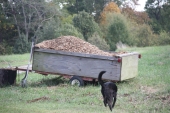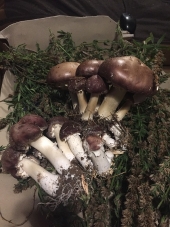

 15
15




Some places need to be wild
 4
4




 13
13




"Study books and observe nature; if they do not agree, throw away the books." ~ William A. Albrecht










 5
5




Some places need to be wild
 1
1




"Study books and observe nature; if they do not agree, throw away the books." ~ William A. Albrecht
 4
4














 6
6




Some places need to be wild
 6
6














 2
2




Some places need to be wild
 3
3




yes they do. nearly all the 3in. i put on in the spring is gone by fall. left over is beautiful black soil full of worms. when i fertilize with compost , i place that down then cover with the sawdust. i use only organic and the wine caps love it as well as the plants. I've mixed in some blewit spawn in composted sawdust and did the same and now i get a mix. wine caps in summer, blewits in fall.Eric Hanson wrote:Steve,
I don't suppose you know how well your bed was composted after the harvest? If you need to add more sawdust each spring, it sounds like the wine caps really break down the wood quickly.
Eric










 3
3




Some places need to be wild




the quickest way to spread the mycelium is to make your pile flat 12in. after mixing in the spawn. then turn your pile every few months till all the chips turn white, which means its colonized. the mycelium needs soil contact and air. too big/tall a pile and it won't colonize properly. once your chips are all white you can mix in the same amount of these, as the original spawn you started with, to start another pile. if your not growing out the shrooms use elm oyster spawn. it colonates a lot faster than wine caps. your pile could be colonized in 3 months or less.Eric Hanson wrote:Steve, since I am not growing mushrooms for harvest as much as I am growing them for their composting abilities, this sounds absolutely perfect! To be able to break down 3 inches of woody material in one season sounds amazing! And worms to boot. I am curious as to how this will work in my wood chip pile. I imagine that my first ring of Mushroom spawn should be right near the base of the pile where hopefully they will decompose sufficiently close to the ground level that they bring worms into the pile itself. My plan then is to plant in successively higher rings up the pile until I run out of spores. Perhaps by the end of the summer I can peal off the outer layer of material and distribute it as a garden bedding material. I don't think I can break down my entire pile in one season, but then I don't expect this to be a 1 year project. Thanks for the insight, this thread is really giving me high-hopes!
Eric










 1
1




Some places need to be wild
 1
1














 1
1




Some places need to be wild
 1
1




the more contact the mycelium has with the sawdust the better. wet your sawdust well. break up your spawn into tiny pieces then mix thoroughly .can cover it with straw , chopped up cardboard or burlap. make sure your ground is cleared down to the dirt as soil contact is important. mycelium spreads quicker if disturbed occasionally. so turning the pile every couple months speeds up the process. for shrooms to grow you would need to leave it alone . don't turn more often as it will weaken the spawn. also , going back to your 1st post, don't add any manure because too much nitrogen kills mycelium. compost that separately. also for your 1st. run only use a 6' by 6' by12'' high pile to start w/ those 2 kits. once that is colonized you can use that pile as a starter to start other piles. you need at least 1/4 your pile amount total to be spawn or it won't colonize. get some oyster spawn if you want results in half the time. good luck!Eric Hanson wrote:Steve,
Just so I am clear, after I flatten the pile, I add spores and then stir? I have never worked with fungi before and I have read that you want to leave the little mycelium alone. On the other hand, If I have moldy bread, breaking the bread in half does not stop the mold from spreading. I was originally planning on poking the spawn into little holes on the side, but now I should drop this idea and spread on the pile itself. Should anything go on top of the spawn (cardboard, etc,)? By the way, thanks very much for your input, it has been very helpful.
Eric










 1
1




Some places need to be wild




you got it. just don't turn more than every few months as it won't t allow good colonization. think of mycelium like roots. small roots separated from the plant won't regrow but bigger ones will . needs to be well established before disturbing. good luck Eric.Eric Hanson wrote:Steve,
So per your recommendations, I will not add any more chicken litter, but I will thoroughly mix up the existing litter into the chips. I don't think I can effectively un-mix the litter already mixed in. I will take a couple of scoops off the pile to use for mulch and spread out the rest to get a broader, flatter "pile," add the spores when they arrive and cover with something carbonaceous and organic. The pile is located directly on ground so ground contact should not be a problem. After I start seeing more white mycelium, I will stir/turn the pile to really get the pile inoculated. Also, turning the pile does not really harm the fungi but will inhibit mushroom production. As far as moisture, there has been so much rain lately that I can't imagine that it would be dry anywhere, but I will monitor the chip moisture.
does this sound about right?
Thanks again,
Eric










 1
1




Some places need to be wild










 1
1




Some places need to be wild
 1
1




as long as you don't mix the chips in with the soil, i don't see why not. wine caps grow well around plants and vice versa.Eric Hanson wrote:So I got my Wine Caps this week--just in time for a snowfall! In this region we never get snow this late, but it happened this year. I still want to get that garden bed of wood chips inoculated as soon as practical, but I had yet another thought on this project. Would it be possible to dig fertile holes on the wood chips and plant tomatoes? My thought was that the tomatoes would help add some dappled shade for the mushrooms and I could still get use of the garden bed this year. I would still have the mulch inoculated 6-8 weeks before the tomatoes would go in. Would the fertile hole interfere with the wine caps growing or would they grow independently of each other? I am thinking fertile holes as the wood chips are 12 inches thick. If anyone has a thought or a different version of this plan, please let me know.
Thanks again in advance,
Eric










 1
1




Some places need to be wild




your welcome. good luck and let us know how it goes.Eric Hanson wrote:Steve, thanks again for the quick reply,
No, I won't mix up the soil and chip. I will fully inoculate the chip bed soon, and plant the tomatoes later. When I inoculate, I will gently mix the spawn into the upper layers of the chip pile and then let them sit. When I put in tomatoes, I will dig little holes in the pile, re-fill with a good tomato soil mix and then cover with the chips once again. I thought this would be an extra "permie" step as the mushrooms and the tomatoes will be assisting each other--the mushrooms make good soil and release nutrients for the tomatoes while the tomatoes make shade for the mushrooms. With luck, by the end of the season I will have some pretty good garden bedding. Incidentally, I am giving some very serious consideration to your suggestion of adding in some oyster spawn to the shroom mix. Thanks again,
Eric










 3
3




Some places need to be wild










 4
4




Some places need to be wild


















Some places need to be wild















 4
4




Some places need to be wild










 4
4




Some places need to be wild










 1
1




Some places need to be wild










 2
2




Some places need to be wild

 6
6




List of Bryant RedHawk's Epic Soil Series Threads We love visitors, that's why we live in a secluded cabin deep in the woods. "Buzzard's Roost (Asnikiye Heca) Farm." Promoting permaculture to save our planet.
 3
3




"The rule of no realm is mine. But all worthy things that are in peril as the world now stands, these are my care. And for my part, I shall not wholly fail in my task if anything that passes through this night can still grow fairer or bear fruit and flower again in days to come. For I too am a steward. Did you not know?" Gandolf














 2
2




Some places need to be wild










 3
3




Some places need to be wild














 1
1




Some places need to be wild

|
Villains always have antidotes. They're funny that way. Here's an antidote disguised as a tiny ad:
The new permaculture playing cards kickstarter is now live!
https://www.kickstarter.com/projects/paulwheaton/garden-cards
|








